On Tuesday 7th November 2017 we hosted a memorable and successful seminar which started with presentations on the specifics of public toilets, but broadened out [as we had hoped] towards wider discussions about public space and social justice.
Responding to Toilet Debate: 3 Questions for Localities
To pick one message from the day is quite easy: Clara Greed said that: “We have to talk toilets because if we’re too embarrassed to talk about them then we won’t get policy right.”
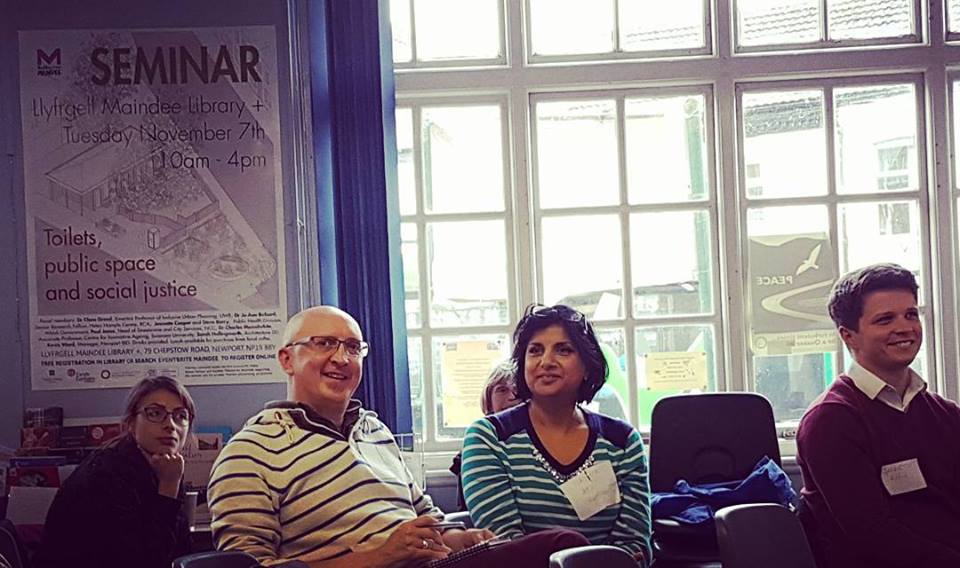
This blog article gives us a resume of the day and sets out what a small charity like Maindee Unlimited, based in a very specific locality, may be able to do to protect and provide public toilets in a place like ours. As such we will explore the following questions: (1) how can communities organise around issues of provision e.g. for consultations like the one which we learned will happen in Wales in 2018; (2) can toilets become/make desirable urban destinations and (3) Are Local authorities still the best-placed provider for toilets?
Background and frame for the seminar
As reported previously on this blog, local charity Maindee Unlimited organised this seminar for a number of different reasons. Firstly, the Maindee toilets on Chepstow Road have been closed, albeit temporarily, by the Council. As a charity representing this community we have to do something. Secondly, the funding we have for the Finding Maindee project from the Arts Council of Wales through Ideas: People: Places gives us the opportunity to put on a free event where people can learn more. We also have some resource to do some work to the land around the Chepstow Road toilets.
In terms of finding an answer to the problem of provision, it was 2015 when the charity first thought about a makeover for the toilets on the corner of Chepstow Road and Livingstone Place [AKA the Triangle]. The charity sought an asset transfer [sic] of both these toilets as well as the library over the road and applied to Big Lottery Fund for some money. We got a development grant which paid for the design work to make a destination of the Triangle and get planning permission [March 2016]. However, amongst other reasons why the Big Lottery Fund did not support the eventual project, they saw public toilets as the duty of the local authority.
In October 2016 we decided to pursue a more modest refresh of the library building. The Triangle did not remain forgotten however; enthusiasm was found to engage architects KHBT and we have a new proposal for the land at the Triangle [more on question 2 below]. Again we have support from Newport City Council to get a lease on the land, but unlike in 2016 the toilets are now closed. Effectively the land itself and an unused building are the only assets to transfer as we are not sure what support Maindee will get from the local authority [read more on question 3 below] to have some toilet provision.
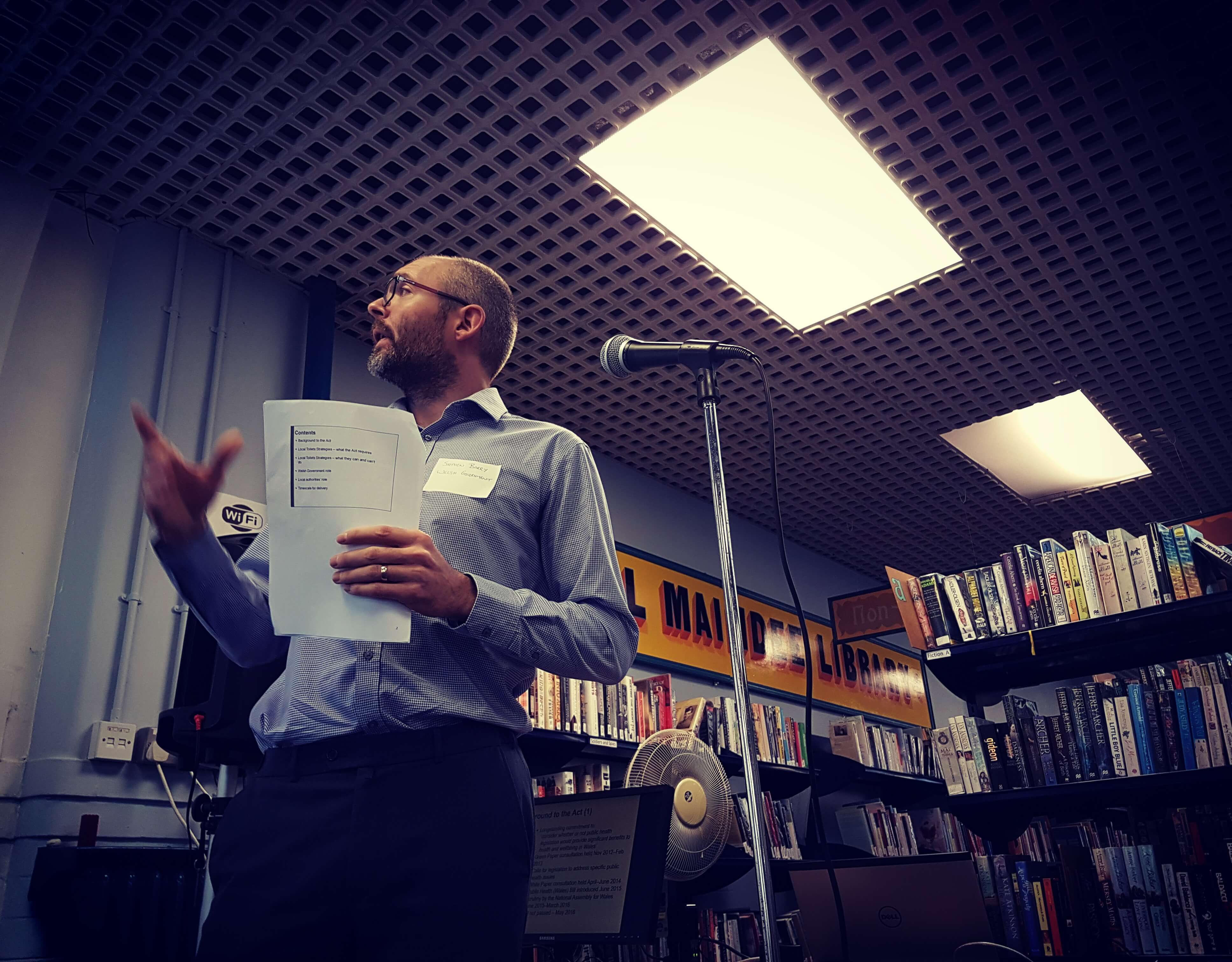
With support from the Arts Council of Wales we decided to put on the seminar. The morning of presentations grouped around the public health debates and specific toilet research; we are grateful for the Welsh Government’s Stephen Barry [pictured above], Clara Greed from UWE and Jo-Anne Bichard from the RCA - presentations found in the links section. After a lunch time look at Livingstone Place and Dafydd Williams’ camera obscura photos taken the Triangle, we held a panel discussion about public space and social justice. Replete with reflections from the morning Ruth Essex from the Arts Council of Wales, Charles Musselwhite from Swansea University and Kevin Ward from Newport Now BID [who relied on the Twitter discussion] all responded to the day and provided a more rounded view of the toilet issue.
The seminar was very dense with discussion so the rest of this article focuses on the three questions outlined at the head of this blog. There is otherwise a good write-up on the South Wales Argus website and for those interested in the wider debate about gender and toilets take a look at Clara’s presentation and links from there. There is also too much important detail from Jo-Anne’s presentation on design issues than we can synthesize in this blog article; again follow the links at the bottom of this blog article.
1. How can communities [like Maindee] organise around issues of provision?
Stephen Barry was the first presenter at the seminar. He explained that Welsh Government will have provision under the Public Health Act (Wales) to make local authorities first consult to assess local need [from May 2018] and then prepare a Public Toilet Strategy [for May 2019]. Importantly this does not mean that local authorities will have to provide toilets within places like Newport, but more that they facilitate provision. Welsh Government are pinning most of their hopes on a community model where businesses provide toilets which are accessible by the public – or perhaps for charities like Maindee Unlimited take them on.
Before we go into the possible detail for Maindee and Newport, it is worth understanding some of the insights shared by Jo-Anne Bichard’s research into public toilet provision. The main body of Jo-Anne’s public toilet research work at the Helen Hamlyn Centre for Design [at the Royal College of Art] is and was concerned with the cultural use of toilets and the design of the facilities themselves - producing a design guide for inclusive toilets with 50 different features. However, the research team also got involved in the mammoth task of producing the Great British Public Toilet Map website. This online resource has been compiled through the RCA with help from different local authorities and, in the case of Newport, by contributors such as our very own John Hallam.
This latter website may seem as far away as possible from the arts as can be possible. However, what both the RCA and Maindee Unlimited have both done is to use different methods to meet people and explore what is around them. Jo-Anne [pictured below] explained that many people do not easily read conventional two-dimensional maps; instead they have their own mental maps of space. Interestingly the research highlights cases where women often have a better understanding of where a toilet may be than men, using descriptions such as: “there is one in Debenham’s on the fifth floor”. The RCA’s research included interviews with 121 people to represent each stage of the lifecourse; that’s to say people with babies [age 0], to teenagers, parents and even someone aged 101.
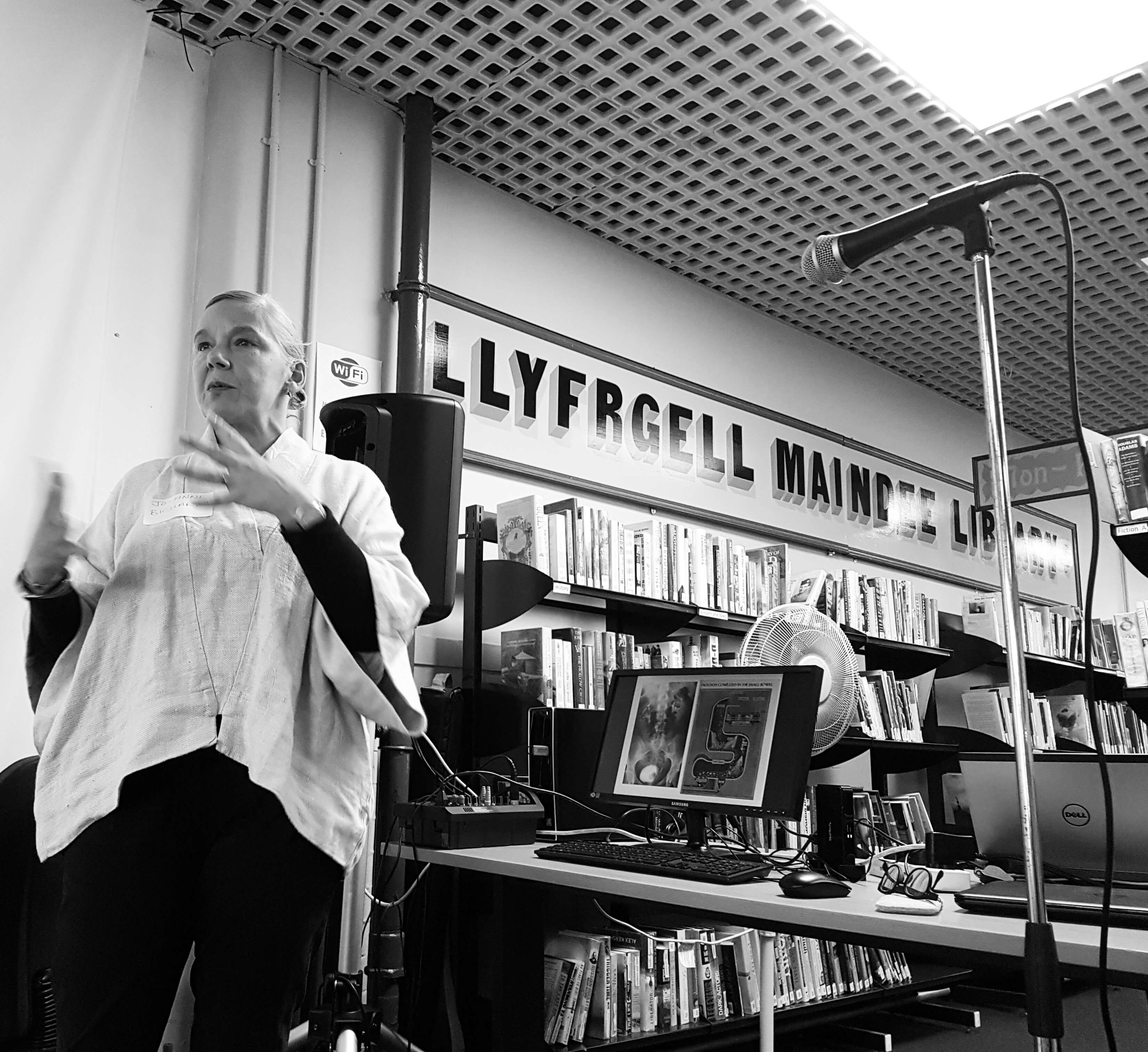
During the session the RCA’s toilet map of Newport was projected as a backdrop. The local context provoked questions posed to Stephen and Jo-Anne. For example Maindee resident Maria Colley asking how often https://greatbritishpublictoiletmap.rca.ac.uk/ is updated. Jo-Anne answered that the page is updated at 24 hours notice; and that it uses resources such as Google Earth as they cannot visit every location. Maria wanted something which was much more locally responsive. Stressing the local-natinal issue, Susan Cunningham, from the British Toilet Association, confirmed that toilet provision is definitely a UK-wide issue, albeit with very local implications.
Coming back to the local we hope that the Council, represented in the morning by Cllr Deb Davies and Welsh Language & Equalities Officer Joe Lewis, will use the ideas shared as a starting point. Stephen Barry explained to Joe that Welsh Government would provide guidance to local authorities in December 2017 on how to conduct the toilet needs assessment. In the case of Newport we know that they are constantly being forced to cut their spending, but from today we can’t tell if they have any ideas as their representative did not turn up to take his place on the afternoon panel session.
There were doubts from Charles Musselwhite and Jo-Anne that the community model would work; the latter cited a case where Marks & Spencer stores in two neighbouring London boroughs had completely different approaches to the same issue. Stephen Barry explained that Welsh Government had previously offered money to shops willing to provide toilets available to the public; albeit that this scheme was now delegated to local authorities. And so this is where we maybe have to accept that each locality will have different opportunities and that Maria’s comments about communication can easily be taken for granted. For example, it may be possible for Maindee Library, with its active Facebook page and ability to display signage in the window, to at least let people know what is happening locally. As we develop ideas for the Triangle with KHBT there is a maybe opportunity to ask about toilets which go within the building?

Although the trustees of this charity need to debate this issue in some depth, we may be in a position to do some focused research once Welsh Government release their guidance in December 2017 and Maindee Unlimited may also be able to provide the Council with evidence in the summer of 2018. And maybe the artistic approach could work in terms of understanding how people map space? Mark Stephenson, pictured above second from left and who has worked in Swansea with Higher Street International, explained that it takes a lot of effort to represent people. However, he was positive that people will go to an area if they know that there is a good toilet...
Mark’s point helps us to conclude this question and move on: that it is perhaps a question of how much a place wants to be somewhere that other people visit; or rather whether a place wants to be somewhere that locals will want to stay in for their shopping, trips to cafes and so on? Coming from a planning perspective, Clara Greed argued that “space matters” and few would dispute that we have an ageing population who can become what Charles Musselwhite called “prisoners” of that space as they get older. We have to fight for our localities; and so how can we make toilets part of desirable urban locations?
2. Can toilets and good design become/make desirable urban destinations?
Ruth Essex explained to seminar delegates that the Arts Council of Wales’ Ideas: People: Places programme is about working with architects and artists to see what good design can achieve for localities. The Arts Council of Wales stress that we should be socially-engaged and try to understand the culture of people and places - similarly to Jo-Anne’s research approach - before any project. As such, a lot of our work is to find the grain and culture of the place and putting this into the designs that we have for the Triangle and Maindee Library.
So if we try to understand what’s here already then do we believe in the idea of place making or creating a destination anyway? We know from Ismael Velasco’s Theatre for Change project and our Maindee Shop Local campaign that people come to the Maindee area rather than go to out-of town shopping because there are many social groups and a collection of hairdressers, good places to eat, banks, chemist, butchers, bakers and back street boozers. Maindee is a neighbourhood away from the centre of Newport which has good bus connections and a car park. In fact, Charles Musselwhite argued that places it is places like this on the outsides of town and city centres where the population is ageing the fastest. Given Maindee’s role as a neighbourhood or district centre - which has definitely been a destination for a very long time - then it probably deserves to have some public toilets. The question is how to properly assess need and make it all work...
Readers of this blog will pick up that our work is not about gradually gentrifying Maindee… that’s to say we don’t believe that making a place more expensive to live is going to solve many issues. Indeed Dafydd’s images taken from Livingstone Place depict a broad range of local residents. Many families living on Livingstone Place feature in the images according to Fez Miah, who spoke to many people as their portraits were taken in the half term week of October 28 to November 3. We know that people will give approximately 20 minutes to an experimental photographic process which did not always work... so we hope this suggests willingness to give some time in the future if we ask them questions about toilet provision. Fez suggested that a blanket survey is unlikely to get the best results so using artistic methods to start the relationship should help long term.
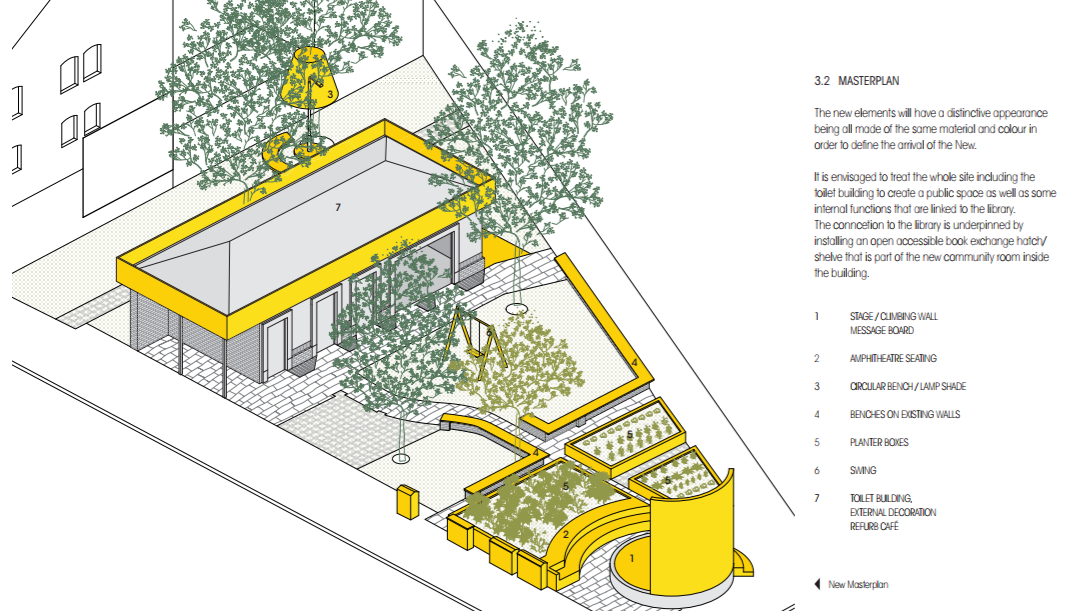
Over the next few months Maindee Unlimited will take through a planning application for the land at the Triangle - see design proposals here and the access statement - which includes the currently-closed toilet block. Again we have been supported in this work by the Arts Council of Wales for the design and funds towards implementation. Ruth Essex, from the latter organisation, put forward the example of the Kawakawa toilets in New Zealand, designed by Hundertwasser, as being very popular and beautiful.
For Maindee we know that people are resourceful and build things over a long timescale. We are therefore looking to keep the site layout [see image above] roughly the same as what it is already: bring some vegetable planting to the front of the site; have a recreational space in the middle with a swing for families to relax in and also get planning consent for some of the toilet block to be used as a cafe. Potentially the charity could find a business who would want to lease the space for the cafe. At the moment we are hoping to develop an inclusive and useful space around the toilet block. The operation of the toilets themselves is going to still need need more thinking...
To conclude this point, it is worth reminding ourselves that results of the obsession with location, location, location are complex. Many places have high house prices and are desirable in terms coffee shops, proximity to parks and so on, but they can also suffer from toilet problems. In the afternoon Ruth Essex talked about a popular part of Bristol has an emerging - and unexpected - need for toilets. It seems that many people rely on seasonal work on festivals and events and are unable to buy property. These are younger people who spend autumn and winter months living in campervans and vans parked in the street and so do have not proper access to toilets and bathrooms. Bristol is a city which is second only behind London in terms of economic performance. Ruth explained that some people are offering access to bathrooms in their own houses as a way to solve the problem. Clara [pictured below] suggested that this was not a long-term solution…
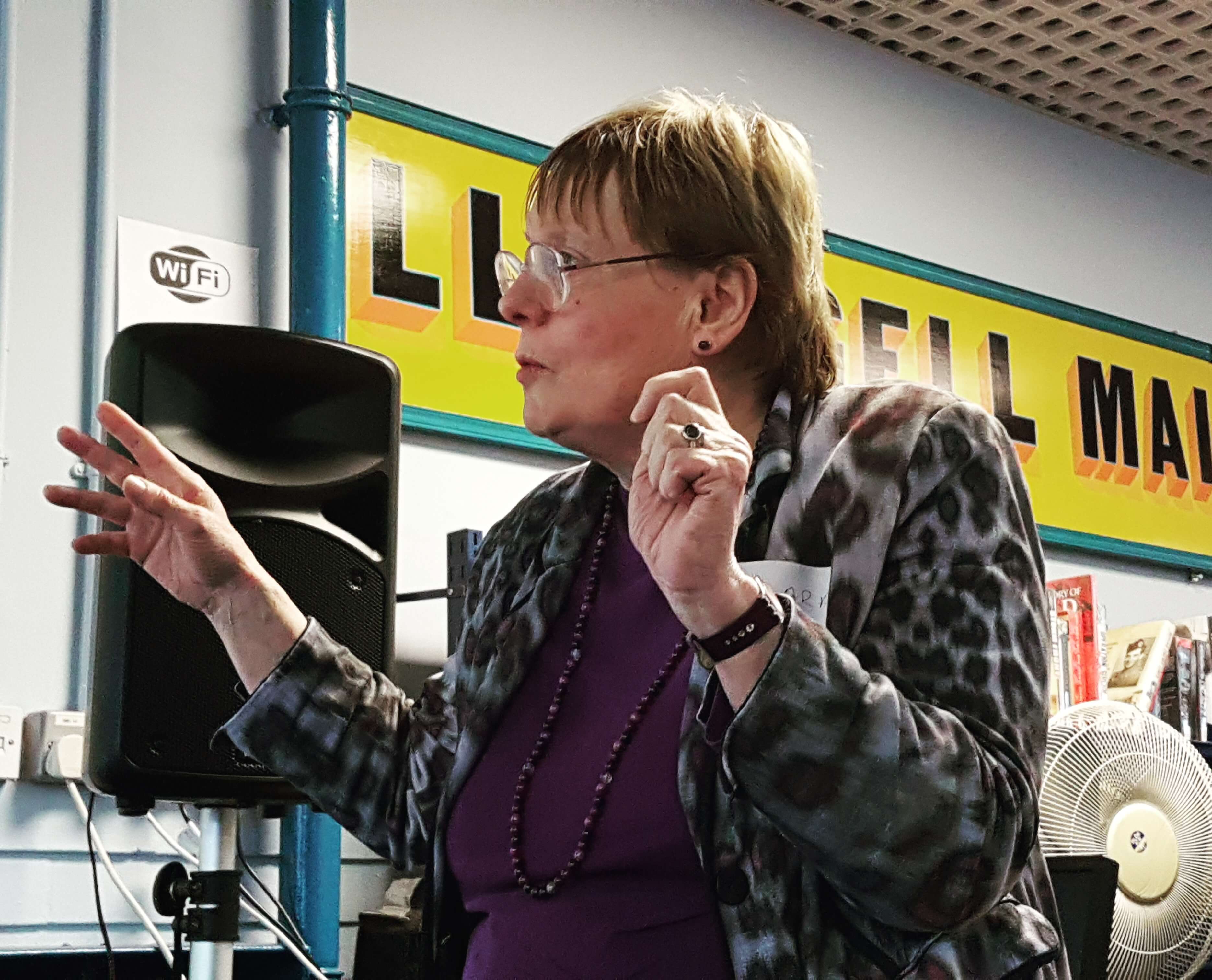
If you read this far, then you will probably be pretty convinced about the need for toilets. And so we link to the final question about who should provide public toilets and whether it is fair that they get closed...
3. Are Local authorities still the best-placed provider for toilets?
Asking whether the Council is best-placed body to provide for toilets was always going to be the hardest question to pose... We did invite somebody from the Council to be on our panel in the afternoon, but they did not come on the day, nor did they give apologies. We know that all local authorities have pressures put on them by budget cuts, but there are choices to be made at a local level. We know that Maindee library is run by volunteers and that we are now considering the future of the local toilets also. However, some other parts of Newport have both libraries and toilets maintained and open for the public free of charge. The panel speakers gave their perspective on social justice to conclude the session.
Ruth Essex put forward the example of the Bear Pit in Bristol; a site near the central bus and coach station which has long suffered from anti-social behaviour. A few years ago the Council licensed land to the Bear Pit Improvement Group of artists and activists. This approach had brought in traders and organised events around the spot where toilets are located. However, Bristol City Council still run the toilet facility. Indeed those of us who went from Maindee to the Bear Pit last December know that lots of homeless people live in and around the site and that it remains a challenging space – read our blog from December 2016. Like Ruth’s other example from Bristol, there is great social need even in spaces and places where property prices continue to climb.
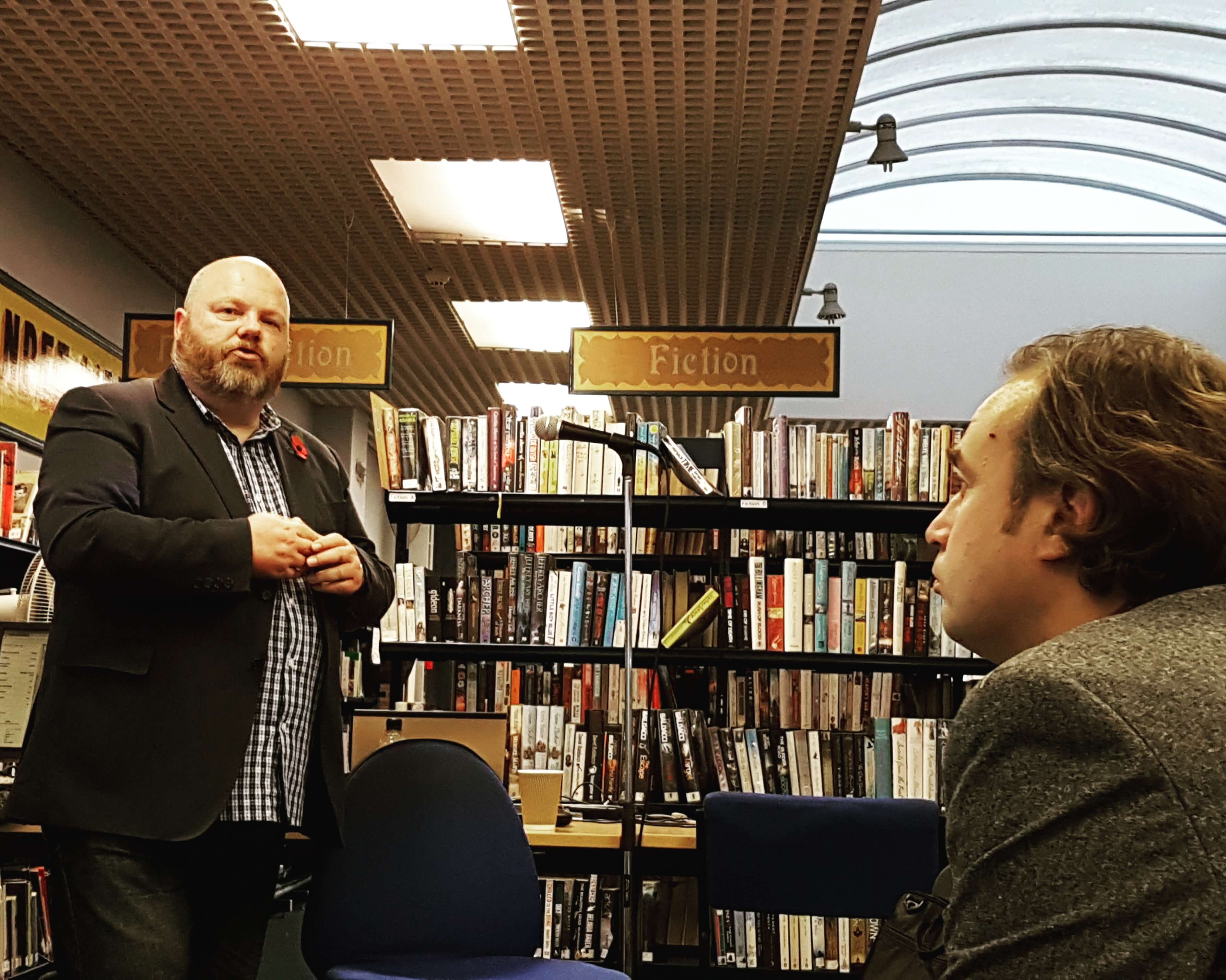
Returning to Newport, Kevin Ward [pictued above] from the Newport Now Business Improvement District [BID] described how the centre of Newport is based around the main trading thoroughfare on Commercial Street with the Friar’s Walk centre - opened in 2015 - roughly at the middle. Kevin explained that Newport Now collects a levy of 1.2% on top of business rates from shops and other businesses in the centre of Newport. In total the BID raises £230,000 and spends it on things like Christmas lights, the Big Splash, street ambassadors and a new scheme for a digital gift card for the city centre. He stressed, however, that they are not here to do things instead of the Council. Like gerontologist Charles Musselwhite, Kevin can see that Newport has an ageing population and an increasing number of people aged 50 plus are now moving into the centre. People need services.
Charles Musselwhite works at Swansea University and gave the perspective of public toilets through researching gerontology: the process of ageing and the study of the older population. He stressed the importance of people feeling connected to where they live as they get older. He said that toilets were one of the four most important issues for older people as they consider the outside environment - alongside benches, pavements and benches. He made the point about closing toilets as short term financial savings which put long term costs somewhere else as people have reduced mobility and worse health. This is one of the main reasons why the toilet strategy is a key component of Welsh Government’s public health demand for local toilet strategies. Charles described the democracy of the street: a place of compromise for civil life. In this sense there is a wider debate for people in every place to discuss whether they think their local authority should be providing toilets as a public service which helps to streets alive and inclusive.
And what next?
We hope that this blog post gives some perspective on the public toilet debate and that we are asking the right three questions for localities such as Maindee in Newport. We sense that most people feel very strongly about this issue. Indeed, our morning speakers Jo-Anne and Clara have lots more information shared on the day that this blog post does not give much space to.
We aim to retain some public toilet provision with our arts-led project at the Triangle. If you would like to get involved with the latter project then contact us via info@maindee.org.
For the wider Finding Maindee follow our work on Instagram, Facebook and Twitter pages or contact via aled@maindee.org or fez@maindee.org .
Thanks again to all contributors and for those who came on the day #toiletjustice!!
Many links with article above and presentation links below.
Public Health (Wales) Act Public Toilet Strategies - Steven Barry
The Great British Public Toilet Map - Jo-Anne Bichard
Inclusive Public Toilet Planning - Clara Greed
The Case of the Publicly Accessible Toilet - Jo-Anne Bichard